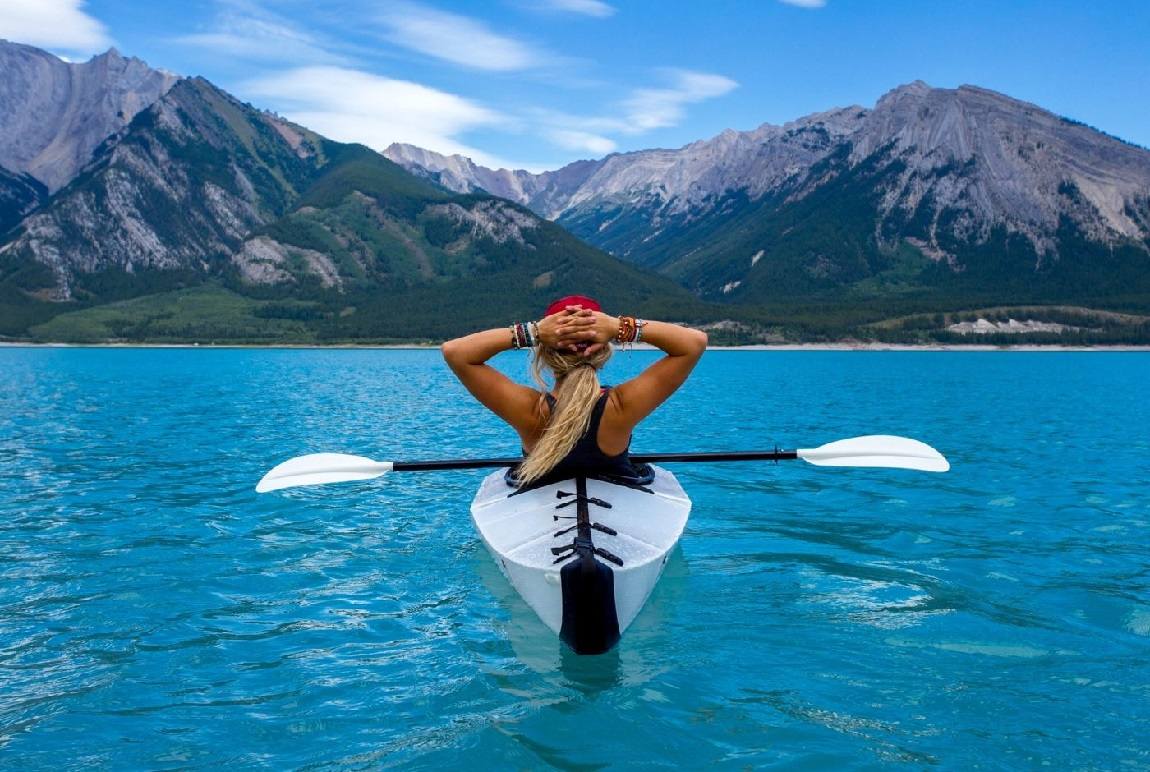If you’re looking for a fitness activity outside the ordinary, kayaking is a top contender. Kayaking is much more universal than you realize; in fact, it can be enjoyed as a serious sport, a leisurely endeavor or an active water adventure, and at any level you choose to participate, kayaking involves some form of physical fitness.
Contrary to what it may seem, kayaking is not for the already fit. Kayaking can be enjoyed by any able-bodied person from toddlerhood and up. The health benefits of kayaking match or even surpass other forms of exercise in strength conditioning and endurance training. Beyond that, kayaking can enhance your mental health through meditative or exhilarating experiences.
Find a Partner
Contrary to what it may seem, kayaking is not for the already fit.
For ultimate fitness accountability, grab a kayaking partner. Having a partner to kayak with can enhance your fitness benefits further than going solo, but choosing the right partner is key. Your kayaking pal should be someone you wouldn’t want to disappoint. If you feel you have a responsibility and commitment toward someone you respect, you’re more likely to follow through and try harder than you would otherwise. Who could possibly be your best kayaking partner? Well, your significant other of course! A study from the Department of Kinesiology at Indiana University surveyed married couples who participated in physical exercise and found that those that worked out together had a mere 6.3% drop out rate while those who worked out separately had a 43% dropout rate.
Here’s another major reason to kayak with your significant other, tandem kayaking is a popular stepping stone in marriage retreats because it requires the duo to communicate and move in sync through the challenge. Who knew kayaking acts as a form of couples counseling – that’s a bonus!
Grab your partner, get your paddle in the water and go! Here are the fitness facts to get you motivated:
Strength conditioning
Kayaking requires loads of low-impact movement that works with the natural resistance of the water. In order for your kayak to remain in motion, you must remain in motion. The activity of paddling involves a heart-pumping upper-body-centric cardio workout that targets the chest, back, shoulders and arms. Your abdominals and obliques drive your torso rotation that ultimately pushes your paddle strokes. The power from your torso rotation is transferred through your arms and shoulders and into the paddle via the stages of the kayaking stroke. While challenging your upper-body, kayaking is also suitable for your lower body. Although your legs are not doing a lot of weight-bearing movement, they play the primary role of stabilization. Your hips and legs help lean, balance and even direct the kayak. To challenge your lower body even further, include lots of direction changes in your kayaking adventure. The entire body in full effect!
Calorie blaster
People who don’t enjoy other cardio blasters like biking or running or need a change of scenery while having a little more fun, kayaking is the right choice. If you stay in action throughout your kayaking adventure, you can burn many more calories than you would during your average trip to the gym. According to the American Council on Exercise, a 125-pound person burns 283 calories/hour of leisure kayaking, a 150-pound person burns 340 calories/hour, a 175-pound person burns 397 calories/hour, and a 200-pound person burns 454 calories/hour. Higher body weight requires increased energy expenditure for activity. This calorie-burn may be equivalent to or lower than some other forms of cardio exercise, but over the course of a kayaking excursion, it’s easy to burn more than 1,000 calories. According to the American College of Sports Medicine, enjoyable activities promote exercise adherence and subsequent weight loss.
Mental clarity
A benefit of kayaking that may go unrecognized is the mental health aspect. There are very few physical activities that offer tranquil surroundings with the view of marine life and beautiful horizons. The peaceful exercise of kayaking in a natural setting allows the mind time to collect its thoughts or forget about the world around it for that moment. Studies prove that this leads to stress relief, by triggering the release of brain chemicals that can quickly improve your mood. If you’re anxious, low-spirited or just need to clear your mind, paddling a kayak is guaranteed to improve your mental state.
Choosing the right kayak is key to your fitness adventure, and the main factors to consider before you choose your kayak are comfort, features, and cost. So let’s start with the two main types of kayaks: sit-on-tops and sit-ins.
- Sit-in kayaks are considered the traditional form of kayaking and make up the majority of the kayak inventory. They are often purposed for transportation rather than recreation, and they can be used in choppy waters and even rapids. Sit-in kayaks shelter your lower half from wind and water, so they are great for paddling in cool weather and for those who want to stay dry.
- Sit-on-top kayaks are more user-friendly and my top choice for your recreational fitness excursion. They’re stable and you have no confinement since you can hop on and off so easily. Sit-on-tops are self-bailing, which means they have small holes that allow any water that gets into the kayak to drain out. Sit-on-top kayaks are a great choice for recreational purposes and for paddling with kids who love to swim.
To go solo or tandem? As we’ve established, having a partner along is generally more beneficial for your health, so a tandem kayak would be the choice for this purpose. If you ever find yourself going solo, you can paddle a tandem by yourself though it could be a little more challenging to maneuver since you can’t sit in the middle.
Narrowing down the options of tandem sit-on-top kayaks, there is one kayak in particular that proves to be durable at a reasonable cost – the Strike 120X by Pelican International. This self-bailing kayak is extremely stable with a wide base and is easy to maneuver. Giving the Strike 120X kayak a ride for myself, I am comforted knowing I can save myself without practicing Eskimo rolls like I would have to for a sit-in kayak. Also, the molded seat and padded footrests help me feel secure and stabilized sitting on the kayak. Pelican uses twin sheet thermoforming to produce stiff, strong, and durable polyethylene kayaks, and Pelican inserts additional flotation features for increased buoyancy and safety. When riding on the kayak, the flotation and buoyancy of the product are evident by how it handles unexpected rougher waters. It rides smoothly in calm to mildly choppy waters, but as expected, you will get some front hull slapping when the water gets beyond mildly choppy.
The Strike 120X boasts a few features to make kayaking cozier. For example, the adjustable padded backrest makes sitting so much more comfortable, which comes in handy for our longer excursions. Another feature is the storage platform with bungees, which we use to tote a dry box filled with our essentials. You can find the Strike 120X at retailers for around $500 (give or take depending on your local retailer). Shop around before you settle on a kayak, but keep this one in mind as a safe, durable, wallet-friendly option.








